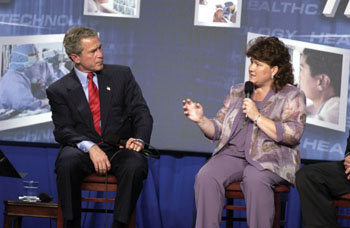
President George W. Bush listens to Jennifer Queen, the mother of a Children’s Hospital patient, during a forum on medical information technology held yesterday at Langford Auditorium. Photo by Daniel Dubois
VUMC keeps climbing NIH funding ranks
Vanderbilt University Medical Center ascended in the National Institutes of Health funding rankings for academic medical centers again this year. VUMC ranked 17 out of 121 medical schools based on funding received in the fiscal year 2003 (Oct. 1, 2002 – Sept. 30, 2003) — up one position from fiscal year 2002.
“I’m very pleased with the gains in this year’s NIH rankings,” said Jeffrey R. Balser, M.D., associate vice chancellor for Research. “Our overall ranking rose and we had several departments move up, with three — Radiology, Surgery and Otolaryngology — making enormous jumps.”
“This is important to our goal of continuing to drive the research enterprise forward. It demonstrates that we are truly growing biomedical discovery at Vanderbilt, and that we continue to gain prominence at national and international levels,” Balser said.
Six VUMC departments placed in the top 10 and six others in the top 20 in their respective categories: Molecular Physiology and Biophysics (2), Pharmacology (4), Cell and Developmental Biology (6), Medicine (7), Other Health Professions (7), Biochemistry (10), Radiology (11), Anesthesiology (12), Pediatrics (16), Surgery (18), and Otolaryngology (19) and Microbiology (20).
Medicine (7), Vanderbilt’s highest-ranked clinical department, moved up two positions — from 9 to 7 —reflecting an increase of more than $15 million in NIH funding.
“These increases in rankings reflect on the growing quality and intellectual diversity of our medical center and the national recognition of research talent here at Vanderbilt,” said Eric G. Neilson, M.D., Hugh J. Morgan Professor and chair of the department of Medicine.
“It is also clear that NIH rankings are not a linear function — they are logarithmic and each increase in position is hard fought. More importantly, our continued rise in rankings further indicates that program development funds used by the institution to advance medical research are being well spent and producing a demonstrable return on investment,” Neilson said.
Molecular Physiology and Biophysics (2) remained the highest-ranked basic science department.
“I think our improved ranking school wide reflects the excellence of our faculty, both the newly recruited individuals, and the many established investigators whose innovative ideas and leadership have led to this accomplishment,” said Alan Cherrington, Ph.D., Charles H. Best Professor of Diabetes Research and chair of Molecular Physiology and Biophysics.
“I'm very pleased that Molecular Physiology and Biophysics has remained number two nationally. I'm even more satisfied, however, by the consistency of our performance as reflected by the fact that we have been in the top three for many years now,” Cherrington said.
Radiology made the largest jump in the rankings, moving up 18 places to 11 in its category.
“The department of Radiology and Radiological Sciences with the Institute for Imaging Sciences has worked very hard over the past four years to restructure our research programs, and we are very pleased that our efforts have been rewarded by the significant improvement in NIH ranking,” said Martin P. Sandler, M.D., Carol D. and Henry P. Pendergrass Professor and chair of Radiation and Radiological Sciences.
Total NIH funding at VUMC increased 17.5 percent to $205.9 million from the previous year. The total number of awards also rose from 458 to 521.
Award data and rankings are available on the NIH Web site at: http://grants1.nih.gov/grants/award/trends/medschc.htm.













